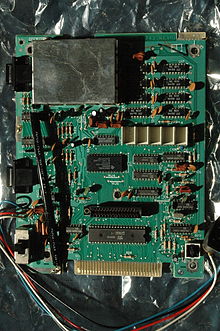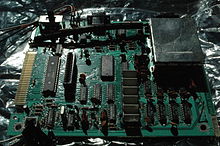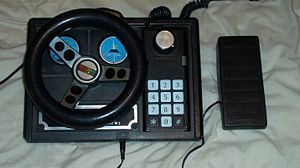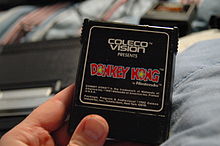- ColecoVision
-
ColecoVision 
Manufacturer Coleco Generation Second generation Retail availability - US August 1982
- EU 1982
Discontinued 1984[1] Media ROM cartridge CPU Zilog Z80 Storage capacity 8/16/24/32 KB Graphics TMS9928A Controller input Joystick/Numeric Keypad
Roller Controller
Driving Controller
Super Action ControllerBest-selling game Donkey Kong (pack-in) Predecessor Telstar Arcade (1978) The ColecoVision is Coleco Industries' second generation home video game console which was released in August 1982. The ColecoVision offered arcade-quality graphics and gaming style, and the means to expand the system's basic hardware. Released with a catalog of 12 launch titles, with an additional ten games announced for 1982, approximately 145 titles in total were published as ROM cartridges for the system between 1982 and 1984.[2] River West Brands currently owns the ColecoVision brand name.[3]
In 2009, IGN named the ColecoVision their 12th best video game console out of their list of 25, citing "its incredible accuracy in bringing current-generation arcade hits home."[4]
Contents
History
Coleco licensed Nintendo's Donkey Kong as the official pack-in cartridge for all ColecoVision consoles, and this version of the game was well received as a near-perfect arcade port[citation needed], helping to boost the console's popularity. By Christmas of 1982, Coleco had sold more than 500,000 units,[5][6] in part on the strength of its bundled game.[7] The ColecoVision's main competitor was the arguably more advanced but less commercially successful Atari 5200.[8][9][10]
The ColecoVision was distributed by CBS Electronics outside of the United States, and was branded the CBS ColecoVision.
Sales quickly passed one million in early 1983,[11] before the video game crash of 1983. By the beginning of 1984, quarterly sales of the ColecoVision had dramatically decreased.[12]
Over the next 18 months, the Coleco company ramped down its video game division, ultimately withdrawing from the video game market by the end of the summer of 1985.[13][14] The ColecoVision was officially discontinued by October 1985.[15] Total sales of the ColecoVision are uncertain but were ultimately in excess of 2 million units, as sales had reached that number by the spring of 1984,[16] while the console continued to sell modestly up until its discontinuation the following year.[17]
In 1986, Bit Corporation produced a ColecoVision clone called the Dina, which was sold in the United States by Telegames as the Telegames Personal Arcade.[18]
Hardware
The main console unit consists of a 14×8×2 inch rectangular plastic case that houses the motherboard, with a cartridge slot on the right side and connectors for the external power supply and RF jack at the rear. The controllers connect into plugs in a recessed area on the top of the unit.
The design of the controllers is similar to that of Mattel's Intellivision—the controller is rectangular and consists of a numeric keypad and a set of side buttons. In place of the circular control disc below the keypad, the Coleco controller has a short, 1.5-inch joystick. The keypad is designed to accept a thin plastic overlay that maps the keys for a particular game. Each ColecoVision console shipped with two controllers.
All first-party cartridges and most third-party software titles feature a 12-second pause before presenting the game select screen. This delay results from an intentional loop in the console's BIOS to enable on-screen display of the ColecoVision brand. Companies like Parker Brothers, Activision, and Micro Fun bypassed this loop, which necessitated embedding portions of the BIOS outside the delay loop, further reducing storage available to actual game programming.
Technical specifications
- CPU: NEC version of Zilog Z80A @ 3.58 MHz (See chip U1, marked NEC D780C-1 in circuit board picture)
- Video processor: Texas Instruments TMS9928A (40 Pin DIP located under the heat sink in the circuit board picture)
- 256×192 resolution (See Display resolution)
- 32 Sprites (See Sprite (computer graphics))
- 16 colors
- Sound: Texas Instruments SN76489A (See chip U20 in circuit board picture)
- 3 tone generators
- 1 noise generator
- VRAM: 16 KB (Chips marked ITT (See ITT Corporation) 8244 4116 3N in the circuit board picture - These are 16K by 1 bit chips, thus there are 8 of them)
- RAM: 1 KB (Chips marked UPD2114LC (U3 & U4) in circuit board picture - 1024 X 4-bit SRAM, thus two chips for 1 KB of memory)
- ROM (See Read-only memory: 8 KB Texas Instruments TMS4764 Mask_ROM (See chip U2, marked TMS4764NL in circuit board picture)
- Storage: Cartridge: 8/16/24/32 KB
Expansion modules
From its introduction, Coleco had touted a hardware add-on called the Expansion Module #1 which made the ColecoVision compatible with the industry-leading Atari 2600. Functionally, this gave the ColecoVision the largest software library of any console of its day. The expansion module prompted legal action from Atari, but Atari was unable to stop sales of the module because the 2600 could be reproduced with standard parts. Coleco was also able to design and market the Gemini game system which was an exact clone of the 2600, but with combined joystick/paddle controllers.
Expansion Module #2 is a driving controller expansion that consists of a steering wheel, gas pedal and the pack-in game Turbo. The driving controller is also compatible with the games Destructor and Dukes Of Hazzard.
Expansion Module #3, the final hardware expansion module, was released in the summer of 1983. Module #3 converts the ColecoVision into a full-fledged computer known as the Coleco Adam, complete with keyboard and digital data pack (DDP) cassette drives. Module #3 was originally conceived to be the ColecoVision Super Game Module using game wafers as the storage medium. Although Coleco presented a mock-up of the SGM at the 1983 New York Toy Show, that product was never manufactured. There were also rumors that Expansion Module #3 was to have incorporated an RCA CED player to store larger amounts of data.
Coleco prototyped a fourth expansion module intended to provide compatibility with Mattel's Intellivision, but this was never released.
Two controller expansions were also available. First was the Roller Controller, a trackball packaged with a port of the arcade game Slither, a Centipede clone and meant to be used with some dedicated games like Victory or to enhance the gameplay of previously published cartridges which benefitted from its trackball system (like Wargames). The second was the Super Action Controller Set, resembling a pair of boxing gloves each with joystick and numeric keypad on top and a series of buttons along the grip. It came with the game Super Action Baseball and saw later release of the Rocky-inspired Super Action Boxing and a port of Front Line.
Similarities to other platforms
The ColecoVision contains the same CPU and graphics chip as the MSX and Sega SG-1000/SC-3000 but the MSX contains a different sound chip, the AY-3-8910. ColecoVision shares the same CPU and a sound chip with Sega Master System, also a similar but inferior graphics chip. For this reason it is not hard to port games between these systems.
Games
Coleco's software approach was to license arcade games that Atari had not. Realizing that Atari had firm support from Namco (the creators of Pac-Man and many other hits), Coleco entered into contracts with companies such as Sega, Konami, and Universal. Given that the ColecoVision could produce near arcade-quality ports, industry magazines like Electronic Games were unanimous in their enthusiasm over the console.[citation needed]
Some of the more popular games include Donkey Kong (the pack-in), Donkey Kong Junior, Carnival, Lady Bug, Mouse Trap, and Zaxxon. Coleco also popularized lesser known arcade games, such as Venture, Cosmic Avenger, and Mr. Do!. In some cases, the console versions were arguably superior to the arcade versions, as seen in Space Panic. Later Coleco continued adapting newer successful arcade games like Subroc, Time Pilot and Frenzy, the company also made inferior ports of many of these games for the Atari 2600 and Intellivision, in an effort to broaden its market[citation needed].
Compared to arcade ports, the ColecoVision did not offer many games original to the console, though a few notable releases are Smurf: Rescue in Gargamel's Castle, War Room, Illusions, and Fortune Builder, an early milestone in the style of SimCity.
Coleco was infamous for its vaporware offerings.[citation needed] An example of such was to be an adaptation of Tunnels and Trolls. It is not known whether the game's printed screen shots were from an actual prototype or were merely pre-development illustrations. The ColecoVision's box itself bears several other examples, among them Chess Challenger, Side Trak, Rip Cord, Horse Racing, and Mr. Turtle.
Legacy
In 1996, programmer Kevin Horton released the first homebrew game for the ColecoVision, a Tetris clone entitled Kevtris.[19][20]
In 1997, Telegames released Personal Arcade Vol. 1, a collection of ColecoVision games for Microsoft Windows,[21] and a 1998 follow-up, Colecovision Hits Volume One.[22]
In popular culture
The value of the ColecoVision as an 1980s pop culture icon was discussed on VH1's I Love The 80's Strikes Back.[23] Several television series have aired episodes that reference or parody the console: South Park,[24] Family Guy[25] and Everybody Hates Chris.[26]
References
- ^ "ColecoVision - 1982-1984". ClassicGaming. IGN. http://classicgaming.gamespy.com/View.php?view=ConsoleMuseum.Detail&id=24&game=8. Retrieved 2008-05-16.
- ^ Forster, Winnie (2005), The encyclopedia of consoles, handhelds & home computers 1972 - 2005, GAMEPLAN, p. 50, ISBN 3-00-015359-4
- ^ "Press release for River West Brands" (PDF). http://www.riverwestbrands.com/news/RiverWest_Underalls_Announcement.pdf. Retrieved 2010-12-20.
- ^ "Colecovision is number 12". IGN. http://www.ign.com/top-25-consoles/12.html. Retrieved 2010-12-20.
- ^ "Coleco hits with home video games", Business Week: 31, 1983-01-24, "Most of 1982's action was in the second half, when Coleco shipped 550,000 ColecoVision game machines--which sell for $169 to $189--booking orders for nearly that many more."
- ^ Video Game Maker Says 1st-Quarter Profit More Than Tripled, Associated Press, 1983-04-20, "Arnold C. Greenberg, Coleco's president and chief executive, said more than 500,000 ColecoVision players were shipped during the first quarter, nearly equaling the number shipped in all of 1982."
- ^ "Coleco's New Video Challenge", New York Times: 1 (Section D), 1982-11-11, "Potential Colecovision buyers have also apparently been attracted by Coleco's licensing agreement with Nintendo Inc., the Japanese creator of Donkey Kong, a current arcade hit, and Universal City Studios Inc. One Donkey Kong cartridge comes with each Colecovision unit."
- ^ Aeppel, Timothy (1982-12-10), "Zap! Pow! Video games sparkle in holiday market", Christian Science Monitor: 7, "In recent weeks, two particularly hot-selling systems have emerged - the Atari 5200 and ColecoVision. Both are described as powerful 'third wave' machines, the Cadillacs of game systems, and priced accordingly at close to $200...[T]hey are sure to snatch most of the Christmas market."
- ^ Harmetz, Aljean (1984-01-10), "Sigh of Relief on Video Games", New York Times: 1 (Section D), "As for game hardware, many experts said that Atari's...5200 or Coleco's Colecovision would corner the high end."
- ^ "Coleco Strong In Marketing", New York Times, 1983-08-01, "Since its introduction last fall, Colecovision has sold about 1.4 million units...Of that total, about 900,000 were sold this year, compared with 800,000 units by Atari and 300,000 by Mattel."
- ^ Video Game Maker Says 1st-Quarter Profit More Than Tripled, 1983-04-20
- ^ [Coleco Industries sales report], PR Newswire, 1984-04-17, "'First quarter sales of ColecoVision were substantial, although much less that [sic?] those for the year ago quarter,' Greenberg said in a prepared statement. He said the company has sold 2 million ColecoVision games since its introduction in 1982."
- ^ "Coleco Reassesses Its Video Games", New York Times (Reuters): 4 (Section D), 1985-06-13, "Coleco Industries is assessing its continuing commitment to the video game business...Arnold C. Greenberg, the chief executive, said no timetable had been set for a decision on continuing or dropping the Colecovision products or on whether the software for the games would continue to be produced if hardware production was discontinued."
- ^ "Video games Coleco may drop out", The Globe and Mail (Canada), 1985-06-21, "Coleco Industries Inc. of West Hartford, Conn., is considering withdrawal from the video game business in both hardware and software."
- ^ "Coleco's Net In Sharp Rise", New York Times (Associated Press), 1985-10-19, "Thursday, Coleco said the entire inventory of its troubled Adam personal computer has been sold, along with much of its Colecovision inventory. The company's chairman, Arnold Greenberg, said Coleco expects no more charges against earnings from the two discontinued products."
- ^ Coleco Industries sales report, 1984-04-17
- ^ Kleinfield, N. R. (1985-07-21), "Coleco Moves Out Of The Cabbage Patch", New York Times: 4 (Section 3), "Coleco is now debating whether to withdraw from electronics altogether. Colecovision still sells, but it is a shadow of its former self."
- ^ "ColecoVision - 1982-1984 - Classic Gaming". Classicgaming.gamespy.com. http://classicgaming.gamespy.com/View.php?view=ConsoleMuseum.Detail&id=24. Retrieved 2010-12-20.
- ^ "Kevtris for ColecoVision - MobyGames". MobyGames<!. 2006-11-29. http://www.mobygames.com/game/colecovision/kevtris. Retrieved 2009-08-24.
- ^ "Classic Videogame Games INTERVIEW - Kevin Horton". Good Deal Games. http://www.gooddealgames.com/interviews/int_horton.html. Retrieved 2009-08-24.
- ^ "Personal Arcade Volume One for Windows - MobyGames". MobyGames<!. 2000-05-21. http://www.mobygames.com/game/personal-arcade-volume-one. Retrieved 2009-08-24.
- ^ "Classic Gamer: Colecovision Hits Volume One for Windows - MobyGames". MobyGames<!. 2000-05-30. http://www.mobygames.com/game/classic-gamer-colecovision-hits-volume-one. Retrieved 2009-08-24.
- ^ "I Love the 80s Strikes Back | Show Cast, Episodes, Guides, Trailers, Web Exclusives, Previews | VH1.com". VH1.com<!. http://www.vh1.com/shows/i_love_the_80s_strikes_back/series.jhtml. Retrieved 2009-08-24.
- ^ "Chickenpox", Season 2 Episode 23, Production no. 210
- ^ "I Take Thee Quaqmire", Season 4 Episode 21, Production no. 4ACX23
- ^ ~Will Harris (2007-06-04). "Everybody Hates Chris: Season One review, Everybody Hates Chris: Season 1 DVD review". Bullz-eye.com. http://www.bullz-eye.com/television_reviews/2005/everybody_hates_chris_1.htm. Retrieved 2009-08-24.
External links
Second generation video game consoles Arcadia 2001 · Atari 2600 · Atari 5200 · Bally Astrocade · ColecoVision · Fairchild Channel F · Interton VC 4000/1292 Advanced Programmable Video System · Intellivision · Odyssey² · RCA Studio II · SG-1000 · Vectrex · Super Vision 8000 · VTech CreatiVision1st generation3rd generationCategories:- 1982 introductions
- Coleco consoles
- Second-generation video game consoles
Wikimedia Foundation. 2010.







